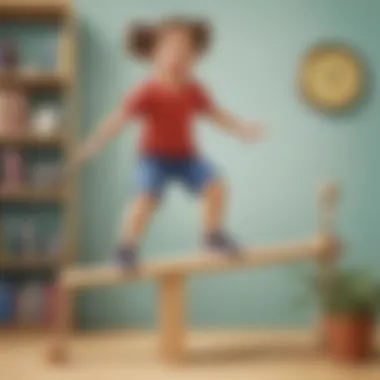Unlocking the Power of Gross Motor Play Activities for Ages 6-12


Science Fun Facts
Gross motor skills development is crucial for children aged 6-12 as it plays a fundamental role in enhancing physical abilities and coordination. Fun activities like jumping, running, and climbing stimulate muscle growth and improve overall well-being. Did you know that engaging in gross motor play can also enhance cognitive functions and boost self-esteem in young learners?
Parents and caregivers play a vital role in promoting gross motor activities for their children. Encouraging outdoor play, organizing obstacle courses, and participating in active games can significantly contribute to a child's physical development and social skills. By fostering a supportive environment for active play, adults can help children in honing essential motor skills and fostering a positive attitude towards physical activity.
Understanding the age-appropriate gross motor milestones can assist in tailoring activities to suit a child's developmental stage. From simple movements like jumping jacks and hopping to more complex actions like playing catch and riding a bicycle, children progress in their gross motor skills at different rates. Recognizing and supporting these milestones is paramount in nurturing a child's physical abilities and ensuring holistic growth and development.
Discover the Wonders of Science
Exploring gross motor play activities transcends mere physical exercise; it introduces children to the wonders of science in a practical and engaging manner. Activities like relay races can illustrate concepts of speed and momentum, while games like tag can demonstrate coordination and agility. By intertwining science with play, children not only enhance their motor skills but also develop a curiosity for scientific principles.
Captivating educational videos and animations can further enrich a child's understanding of the science behind gross motor movements. Visual representations of how muscles work during different activities or the physics of balance and coordination offer a multi-sensory learning experience. Integrating interactive learning tools can make scientific concepts more accessible and hands-on, creating a captivating environment for children to explore and learn.
Science Quiz Time
To reinforce learning and engagement, interactive quizzes centered around gross motor activities can be both informative and entertaining for children aged 6-12. From multiple-choice questions testing knowledge of different movements to brain teasers challenging coordination skills, quizzes can be a fun way to assess comprehension and spark curiosity. By incorporating gamification elements, such as rewards for correct answers or leaderboard rankings, quizzes can motivate children to actively participate and learn through play.
Science experiments showcase the practical application of scientific principles in everyday activities. By conducting simple experiments, such as measuring how far one can jump or observing the effects of different physical exercises on heart rate, children can witness firsthand the science behind their gross motor movements. Providing step-by-step instructions, safety tips, and a list of materials ensures a safe and educational exploration of science through play.
Introduction to Gross Motor Play Activities
Gross motor play activities for children aged 6-12 are essential for their physical and cognitive development. These activities involve movements that engage larger muscle groups, promoting coordination, balance, and overall health. In this article, we will explore a variety of gross motor play activities designed to enhance children's motor skills and well-being.
Understanding the Importance of Gross Motor Skills
The Role of Gross Motor Skills in Child Development
Gross motor skills play a crucial role in a child's overall development. These skills involve movements like running, jumping, and climbing, which are fundamental for daily functioning. Developing strong gross motor skills is vital for children to perform various activities, both in play and academics. They form the basis for more refined motor skills and contribute to overall physical fitness.
Benefits of Encouraging Gross Motor Activities
Encouraging gross motor activities offers a multitude of benefits for children. These activities help improve muscle strength, coordination, and balance. By engaging in gross motor play, children can enhance their spatial awareness and develop healthy exercise habits. Moreover, such activities promote social interaction and teamwork among children, fostering essential life skills.
Overview of Gross Motor Development in Children
Typical Milestones in Gross Motor Development


Understanding the typical milestones in gross motor development is essential for tracking a child's progress. These milestones include sitting up, crawling, walking, running, and more complex activities like riding a bike or playing sports. Each milestone builds upon the previous one, reflecting the child's motor skill progression.
Factors Influencing Gross Motor Skills
Several factors can influence a child's gross motor skills development. Environmental factors, such as access to safe play areas and ample physical activity opportunities, play a significant role. Moreover, genetic predispositions and individual differences in growth rates can impact a child's gross motor skill acquisition. By recognizing and addressing these factors, caregivers can better support children in their motor skill development.
Recommended Gross Motor Play Activities
Gross motor activities hold paramount importance in fostering physical development, coordination, and overall well-being in children aged 6-12. These activities not only enhance muscle strength and endurance but also improve cardiovascular health, laying a robust foundation for their future growth. They play a pivotal role in boosting concentration, enhancing focus, and fostering self-confidence among young learners. By engaging in recommended gross motor play activities, children can relish the benefits of play while honing essential motor skills.
Outdoor Gross Motor Activities
Obstacle Course Challenges
Obstacle course challenges offer children a unique opportunity to develop their gross motor skills through a series of physical obstacles. These challenges aim to enhance agility, balance, and coordination, contributing significantly to the overall physical development of children. The key characteristic of obstacle course challenges lies in their ability to simulate real-life movements in a fun and engaging manner, making them a popular choice among parents and educators alike. The unique feature of obstacle course challenges is their versatility, allowing for customization based on the children's age and skill level, offering a range of advantages in promoting physical activity and motor skill refinement.
Bike Riding Adventures
Bike riding adventures provide children with an avenue to engage in outdoor physical activity while honing their gross motor skills. The key characteristic of bike riding lies in its ability to improve balance, coordination, and muscle strength, offering a comprehensive physical workout. It is a popular choice for this article due to its dual benefits of promoting physical health and fostering a sense of adventure and exploration among children. One unique feature of bike riding adventures is the exposure to the outdoors, encouraging children to appreciate nature while reaping the advantages of improved physical fitness and motor coordination.
Nature-inspired Movement Games
Nature-inspired movement games blend physical activity with elements of the natural environment, creating a holistic play experience for children. These games aim to foster creativity, motor skills, and a connection with nature, making them a beneficial choice for this article. The key characteristic of nature-inspired movement games is their ability to enhance sensory awareness and motor coordination through engaging outdoor play. One unique feature of these games is their adaptability, allowing children to explore various movement patterns in a natural setting, offering advantages like improved physical fitness and cognitive development.
Indoor Gross Motor Activities
Dance Party Fun
Dance party fun offers children a lively and interactive outlet to develop their gross motor skills within indoor spaces. The key characteristic of dance parties is their ability to promote physical activity, sensory integration, and social interaction, making them a popular choice for this article. One unique feature of dance party fun is its capacity to engage children of all ages and skill levels, fostering inclusivity and enjoyment in physical activity. Advantages of dance party fun include improved coordination, rhythm, and cardiovascular health, making it a well-rounded choice for indoor play.
Balloon Volleyball
Balloon volleyball provides children with a safe and engaging way to enhance their gross motor skills while indoors. The key characteristic of balloon volleyball lies in its emphasis on hand-eye coordination, spatial awareness, and teamwork, making it a beneficial choice for this article. One unique feature of balloon volleyball is its adaptable nature, allowing for varied gameplay based on the space available, offering advantages like improved motor skills, social interaction, and physical fitness for children.
Yoga for Kids
Yoga for kids offers a mindful and calming approach to develop gross motor skills and overall well-being in children. The key characteristic of yoga lies in its focus on balance, flexibility, and mindfulness, making it a popular choice for this article. One unique feature of yoga for kids is its emphasis on relaxation and stress reduction, providing mental and physical benefits beyond just gross motor skill development. Advantages of yoga for kids include enhanced body awareness, stress management, and emotional regulation, making it a holistic choice for indoor physical activity.


Interactive Gross Motor Activities
Simon Says
Simon Says is a classic game that helps children refine their listening skills, motor coordination, and cognitive abilities through interactive play. The key characteristic of Simon Says lies in its engaging format that promotes quick thinking, attention to detail, and following directions, making it a beneficial choice for this article. One unique feature of Simon Says is its ability to be customized based on children's skill levels, offering advantages like improved focus, memory retention, and decision-making in a playful setting.
Musical Statues
Musical statues challenge children to showcase their creativity, coordination, and self-expression through movement and stillness. The key characteristic of musical statues is its incorporation of music and movement in a dynamic play experience, making it a popular choice for this article. One unique feature of musical statues is its encouragement of balance, control, and spatial awareness, providing advantages in honing gross motor skills, rhythm, and social interaction among children.
Scavenger Hunt
Scavenger hunts inspire children to explore their surroundings while engaging in physical activity and problem-solving. The key characteristic of scavenger hunts is their blend of movement, critical thinking, and collaboration, making them a valuable choice for this article. The unique feature of scavenger hunts is their adaptability to various settings and themes, offering advantages like improved physical fitness, strategic thinking, and teamwork skills among children.
Incorporating Gross Motor Play into Daily Routine
In this crucial section of the article, we delve deep into the significance of incorporating gross motor play into the daily routine of children aged 6-12. One cannot overlook the pivotal role that consistent physical activity plays in fostering holistic development, enhancing cognitive processes, and boosting overall well-being amongst young learners. By instilling a routine that incorporates diverse gross motor activities, parents and caregivers can ensure that children reap the myriad benefits these activities have to offer. From developing essential motor skills to promoting a healthy lifestyle, integrating gross motor play into daily routines is paramount.
Strategies for Making Gross Motor Play a Habit
Creating a Playful Environment
When discussing the essence of creating a playful environment, we are underscoring the crucial need for the physical space to be inviting, stimulating, and conducive to active play. The environment should be equipped with a variety of age-appropriate equipment, such as balls, mats, and climbing structures, that inspire movement and engagement. Emphasizing safety measures while maintaining an element of challenge is key to sustaining children's interest and motivation. A playful environment fosters creativity, problem-solving skills, and physical endurance, making it a fundamental component in the gross motor play regime.
Scheduling Playtime
The significance of scheduling dedicated playtime within the daily routine cannot be understated. By allocating specific time slots for gross motor activities, children learn to prioritize physical play alongside their academic and other commitments. Structured playtime instills a sense of discipline, punctuality, and routine, instilling healthy habits early on. Whether it's a brief session in the morning or a longer play period in the evening, adhering to a schedule ensures that children receive adequate physical exercise while balancing other aspects of their daily lives.
Involving Family and Friends
Involving family members and friends in the gross motor play activities of children reinforces social bonds, teamwork, and the joy of collaborative play. By incorporating group activities or challenges that require participation from multiple individuals, children not only gain social skills but also derive immense satisfaction from shared achievements. Additionally, involving family and friends creates a support system that celebrates each milestone achieved through gross motor play, fostering a sense of togetherness and encouragement within the familial and social circles.
Balancing Screen Time with Physical Activity
In the digital age, balancing screen time with physical activity is a pertinent concern for parents and caregivers. The proliferation of sedentary behavior amongst children calls for a conscious effort to limit screen time and promote active play choices that prioritize movement and engagement.
Limiting Sedentary Behavior


Discussing the strategies to limit sedentary behavior involves creating boundaries around screen usage, encouraging breaks from prolonged sitting, and introducing alternative active pastimes. By setting clear guidelines on screen usage and designating tech-free zones within the home, parents can mitigate the adverse effects of excessive sedentary behavior. Limiting screen time promotes physical activity, imaginative play, and social interaction, contributing to a wholesome lifestyle for children.
Promoting Active Play Choices
Promoting active play choices entails advocating for games, sports, and recreational activities that involve movement, coordination, and physical exertion. Encouraging children to partake in outdoor pursuits, sports teams, or dance classes cultivates a love for physical exercise and instills habits that support long-term health and well-being. By promoting a variety of active play choices, parents empower children to make informed decisions regarding their leisure time, fostering an appreciation for an active lifestyle that transcends their formative years.
Benefits of Gross Motor Play for Children
Gross motor play activities play a vital role in the development and well-being of children aged 6-12. By engaging in these activities, youngsters enhance their physical health, coordination, and cognitive abilities. Additionally, gross motor play contributes to the overall holistic growth of children by improving their muscle strength, endurance, cardiovascular health, concentration, focus, and self-confidence.
Physical Health and Fitness
Improving Muscle Strength and Endurance
Improving muscle strength and endurance through gross motor play is crucial for children's overall physical development. By participating in activities like climbing, jumping, and running, kids can strengthen their muscles and increase their stamina. This aspect of gross motor play aids in enhancing children's motor skills, balance, and coordination. Moreover, it fosters a healthy lifestyle and instills discipline and perseverance in young learners, setting a foundation for a robust physique.
Enhancing Cardiovascular Health
Enhancing cardiovascular health through gross motor play is paramount for children's well-being. Activities such as cycling, swimming, and jogging promote cardiovascular fitness and improve heart health. By engaging in aerobic exercises, kids boost their endurance and stamina, reducing the risk of cardiovascular diseases later in life. This aspect of gross motor play not only strengthens the heart but also enhances lung capacity and overall physical efficiency, ensuring optimal health in children.
Cognitive and Emotional Development
Boosting Concentration and Focus
Boosting concentration and focus through gross motor play aids children in sharpening their cognitive skills. Activities involving coordination, balance, and quick reactions help improve children's ability to concentrate and focus on tasks. By challenging their minds and bodies simultaneously, kids enhance their cognitive function and attention span, laying a foundation for academic success and cognitive development. This aspect of gross motor play nurtures resilience and determination in children, preparing them for challenges they may encounter.
Fostering Self-Confidence
Fostering self-confidence through gross motor play is essential for children's emotional well-being. Engaging in physical activities and overcoming obstacles builds self-esteem and self-belief in young learners. As children conquer challenges and achieve physical milestones, they develop a sense of confidence in their abilities, driving them to take on new challenges with courage. This aspect of gross motor play promotes a positive self-image and resilience in children, nurturing a strong sense of self-worth and confidence for future endeavors.
Conclusion
Gross motor play activities for children aged 6-12 possess immense significance in fostering their physical, cognitive, and emotional development. Encouraging such activities paves the way for enhancing essential motor skills and overall well-being. By engaging in structured movements, children not only enjoy themselves but also reap the benefits of improved coordination and physical dexterity. The holistic approach to incorporating gross motor play can have a lasting impact on a child's growth and maturity. Embracing these activities as part of a routine can lead to long-term benefits that encompass various aspects of a child's development. Moreover, the sense of accomplishment and confidence gained through these activities can positively influence a child's self-esteem and social interactions. Taking the time to understand and implement gross motor play activities can truly redefine a child's approach to physical engagement.
Embracing Gross Motor Play for Holistic Development
The Lasting Impact of Physical Play
Delving into the lasting impact of physical play reveals a crucial aspect of a child's development. The consistent engagement in gross motor activities not only enhances physical abilities but also instills discipline, focus, and determination in children. The lasting impact lies in the foundation it builds for a child's future physical endeavors. By emphasizing the benefits of continuous physical play, children can achieve long-term improvements in areas such as coordination, balance, and overall fitness. The unique feature of physical play's lasting impact is its ability to create a strong, resilient groundwork for a child's overall well-being and future success. Understanding and promoting a lasting dedication to physical play can shape a child's lifestyle choices and attitude towards health and fitness.
Encouraging Lifelong Habits
Encouraging lifelong habits through gross motor play activities plays a pivotal role in shaping a child's perspective on health and physical well-being. By instilling healthy habits during childhood, caregivers can nurture a culture of physical activity that extends into adulthood. The key characteristic of encouraging lifelong habits is the focus on consistency and enjoyment in physical play. Making these activities a natural part of daily routines establishes a foundation for a healthy lifestyle that children can carry forward. The unique feature of encouraging lifelong habits is its potential to create a positive association with physical activity, making it a preferred choice over sedentary pastimes. Promoting sustainable habits from a young age can set children on a path towards a balanced and active lifestyle that prioritizes their overall health and well-being.







